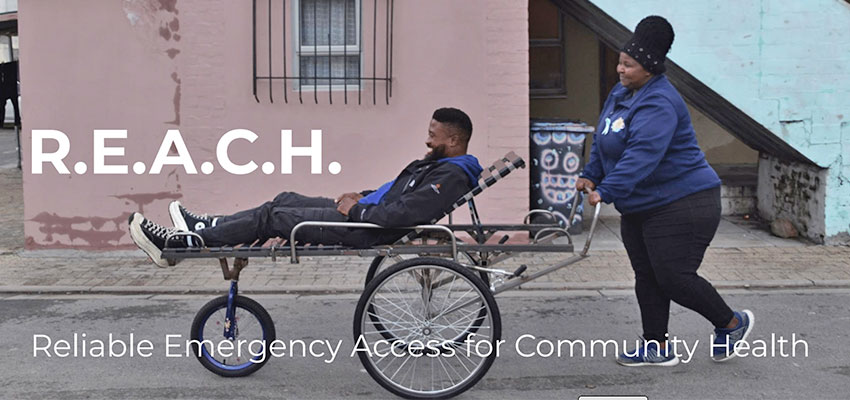
Langa, South Africa: overview
Townships in South Africa are underdeveloped and densely populated Black African areas that were originally formed due to apartheid laws. Homes in these informal communities are often shacks packed closely together, with narrow, winding alleyways connecting them. Langa is the oldest township, located just outside of Cape Town.
Langa does not have its own hospital, and the nearest one is across the busy, multilane N2 highway in a neighboring town. Ambulances called to transport patients here often take hours to arrive—or do not arrive at all. Our project focused on helping the people of Langa reach the hospital more quickly and safely by building a mobile stretcher that could more easily transport patients to quality healthcare.
Our team and goals
We arrived in Cape Town in June with the goal of constructing the stretcher we had designed during the spring semester in our D-Lab: Design class. Our team consisted of Anna Duncan ‘25, Jack Grier ‘25, Avani Narula ‘25, Annica Lam ‘26, and two students from MassArt Michela Galazzi and Maddie Johnson-Harwitz. Most of us had backgrounds in mechanical engineering and industrial design. This design had gone through a few years of iterations, with a D-Lab class each year improving on it. This past spring, we prototyped a stretcher ready to share with the community. Maddie and Michela had previously made a trip to Cape Town in January to identify stakeholders and establish additional partnerships. Once in Langa, we hoped to manufacture the stretcher with a local builder and create a community process for its use.
Building the stretcher
We were introduced to Greg Jones, a local manufacturer, who was willing to help us create a finished product to donate to Langa. Working with Greg taught us a lot about how we could improve our prototype for manufacturing. He helped us refine our computer-aided-design drawings and we learned how to ensure collapsible joints are long-lasting. In addition, to avoid weathering and rusting over time, Greg was able to powder-coat the final stretcher. Before this manufacturing process took place, our team decided it was critical to have a tangible prototype to be able to demonstrate to the community how the stretcher worked. So, in the meantime, we sourced a local welding machine in Langa to put together the dismantled stretcher that traveled with us from the D-Lab workshop.
Project partners
We worked closely with our project partner Lebo Molete, a Tekano Health Equity Fellow, who gave us feedback on which stretcher designs were best suited for the rough terrain of Langa. Lebo introduced us to Mzikhona Mgedle of the Langa Bike Hub, who connected us with the local community. Routine checkups and non-emergency care are provided at the KI Wellness Center in Langa. Our relationship with the community healthcare workers there became one of our most important partnerships.
Understanding Langa
Mzi and the Bike Hub team showed us around Langa and helped us understand the community more deeply. We witnessed the small houses provided by the government after apartheid, as well as informal metal shacks, with families still waiting for their promised homes. We walked from different parts of the community to the hospital and imagined what that trip would be like in an emergency. We also noticed tensions between the hospital—located in a historically colored community—and the Langa healthcare workers, who shared stories of dragging patients in trash bins or wheelbarrows to get them care.
What stood out most was how much our project partners believed in the stretcher and the positive impact it could have in the community. Their enthusiasm came from a deep commitment to improving health access in Langa.
Stretcher system
The support of all of our project partners made it easier to develop a system for using the stretcher. We handed out flyers and brochures to the community that explained what the stretcher is, when to use it, and a phone number to call in case of emergency. The lead healthcare worker would receive the call, determine where in Langa the emergency was, and send a nearby healthcare worker. We created a zone map and compiled a list of workers and their phone numbers to make this process easier. During all of this, a member of the Bike Hub would also be alerted to bring the stretcher to the patient, who would then be walked to the hospital’s emergency entrance. The Bike Hub would return the stretcher and handle any maintenance needed.
Project future
In order to track how effective the stretcher is and identify any improvements needed for future versions, we gave the healthcare workers a data collection sheet. After evaluating the results and making adjustments, we hope to produce more stretchers for Langa and eventually expand to other townships across South Africa. During our trip, we were moved and inspired by all of the incredible, hardworking people we met in Langa. Moving forward, we hope this project can be expanded to continue benefiting South African communities.
The D-Lab team showed off the finished prototype with the healthcare workers to all of Langa during a parade through the township, where flyers were distributed with information on the project. During this parade, two Atlantic/Tekano fellows, including the initial project sponsor Lebo Molete were able to attend and see just how far the project had gone. The other fellow, Yvette Andrews, can be seen on the stretcher.
More information
MIT D-Lab class: D-Lab: Design
Contact
Libby Hsu, MIT D-Lab Associate Director of Academics

